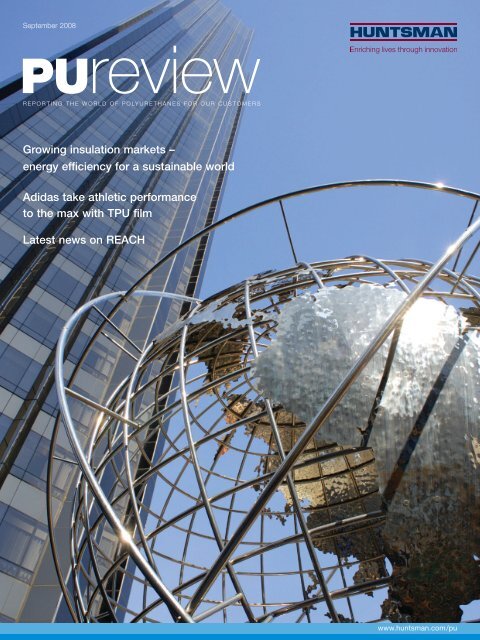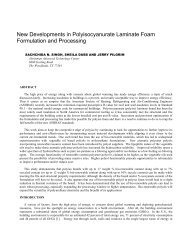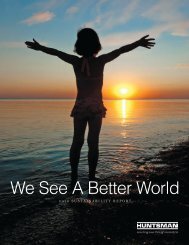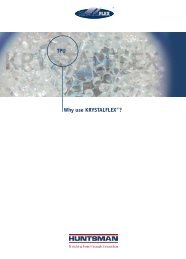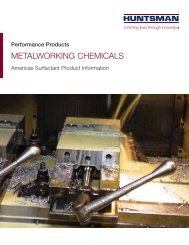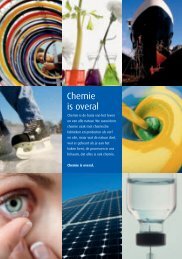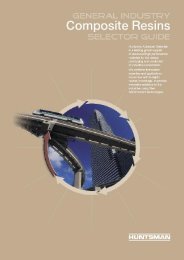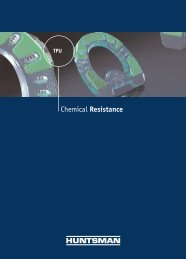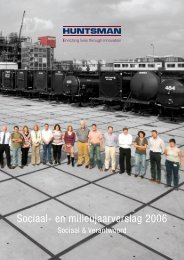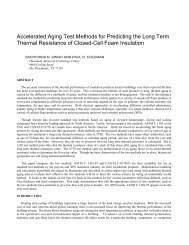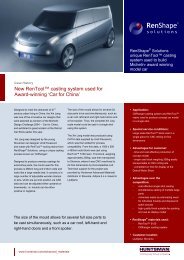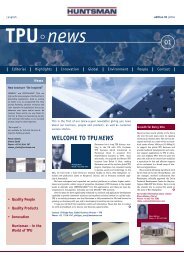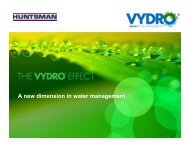PU Review 01
PU Review 01
PU Review 01
Create successful ePaper yourself
Turn your PDF publications into a flip-book with our unique Google optimized e-Paper software.
September 2008<br />
R E P O R T I N G T H E W O R L D O F P O LY U R E T H A N E S F O R O U R C U S T O M E R S<br />
Growing insulation markets –<br />
energy efficiency for a sustainable world<br />
Adidas take athletic performance<br />
to the max with T<strong>PU</strong> film<br />
Latest news on REACH<br />
www.huntsman.com/pu
2<br />
<strong>PU</strong> briefing September 2008<br />
Innovation: the<br />
lifeblood of<br />
our business<br />
Tony Hankins, President,<br />
Huntsman Polyurethanes<br />
Welcome to the first issue of our new, yet<br />
long established, customer newsletter.<br />
Some will remember that we published<br />
<strong>PU</strong> <strong>Review</strong> through the 1980s and 90s, but discontinued the<br />
newsletter in 2004 because of the growth in popularity of online<br />
media. Since then, we’ve received many enquiries from our<br />
original readership base to relaunch the publication, so here’s<br />
our response, “back by popular demand” you could say.<br />
The aim is the same: to give existing and potential customers,<br />
industry groups and academic bodies, the media and others<br />
who are interested in the world of polyurethanes, a flavour<br />
of the many new developments going on in Huntsman<br />
Polyurethanes, with a particular focus on technology innovation<br />
– the lifeblood of our Business. You’ll see as you read the<br />
stories in this issue that much of that innovation has a strong<br />
environmental driver and the main feature focuses on insulation<br />
– a key contributor to improved energy efficiency. There’s no<br />
doubt that these are exciting times for the Polyurethanes<br />
industry and I trust that the newsletter reflects this and hope it<br />
stimulates new ideas for you.<br />
New applications for biorenewable lignin<br />
Huntsman and Lignol Energy Corporation of<br />
Canada have signed a memorandum of<br />
understanding to jointly develop new polyurethanes<br />
applications using bio-renewable high purity lignin<br />
HP-LTM.<br />
Lignin, an agricultural by-product, is one of the<br />
three key constituents of wood, together with<br />
cellulose and hemi-cellulose. It is a highly<br />
functionalized and cross-linked aromatic material<br />
with potential to enhance performance in a wide<br />
variety of polyurethane applications.<br />
“This agreement shows Huntsman’s continuing<br />
commitment to investigate the use of biorenewable<br />
components – both for feedstock and<br />
for product applications”, says Niek Van Wiechen,<br />
Huntsman Polyurethanes Global Director for<br />
Core Science.<br />
New Asia-Pacific Technology<br />
Centre opened<br />
Huntsman has opened a new<br />
Asia-Pacific Technology Centre<br />
(ATC) in Shanghai’s Minhang<br />
Development Zone, giving<br />
regional customers direct access<br />
to a world-class technology<br />
innovation resource. The new<br />
Centre will initially accommodate<br />
research and technical<br />
experts from Huntsman’s<br />
Polyurethanes and Performance<br />
Products divisions, with the<br />
number of specialists expected to<br />
expand rapidly over the next few<br />
years. The ATC team will draw on<br />
the expertise of its counterparts<br />
at Huntsman’s Technical<br />
Polyurea<br />
association<br />
launched<br />
Development Centres in Europe<br />
and the USA, to speed the<br />
introduction of new technology<br />
platforms into the Asia Pacific<br />
Chinese market.<br />
The company’s team of regional<br />
specialists will provide extensive<br />
developmental and testing<br />
support to customers, providing<br />
custom-made solutions for Asia<br />
Pacific markets on a quick and<br />
efficient basis.<br />
Further details about the Centre<br />
and the September 2nd official<br />
inauguration will be covered in<br />
the next issue of <strong>PU</strong> <strong>Review</strong>.<br />
Huntsman has played a leading role in the creation of<br />
the Polyurea Development Association Europe (PDA<br />
Europe), a new industry body set up to manage<br />
polyurea issues related to standards, EH&S<br />
education and REACH.<br />
Marc Broekaert of Huntsman’s Business<br />
Development – Coatings Europe group has been<br />
elected first President of PDA Europe. He comments,<br />
“Creating a professional industry association<br />
committed solely to the needs of European polyurea<br />
formulators and users meets a long-standing<br />
requirement in this fast growing market.”<br />
The association will have close working links with<br />
its sister-organization, PDA Americas (founded in<br />
1999). PDA Europe’s next conference will be held<br />
November 18-20 in Vienna. www.pda-europe.org
Environmentally friendly floor coatings<br />
Tough, easy to apply and flexible<br />
Huntsman Polyurethanes with its MDI technology<br />
and Alberdingk Boley with its environmentallyfriendly<br />
polyols have joined forces to provide<br />
customers with new coatings solutions for<br />
industrial flooring.<br />
In addition to environmental friendliness –<br />
Alberdingk Boley’s polyols are based on renewable<br />
castor oil and therefore 100% VOC-free – these<br />
solutions include increased toughness, ease of<br />
application and flexibility.<br />
The Huntsman and Alberdingk Boley solutions<br />
impart toughness and longevity by providing<br />
elasticity and high performance impact and<br />
abrasion resistance properties; they provide low<br />
viscosity and advanced self-leveling properties to<br />
Low-VOC steering wheel<br />
developed for Perodua cars<br />
Huntsman, working with Taiwan-based component supplier GSK, has achieved<br />
commercialization of a new, low-VOC (volatile organic compound) polyurethane steering<br />
wheel for Malaysian car manufacturer Perodua.<br />
Wee Yoong Lee, Business Development Manager for Automotive in Asia, said: “We are<br />
delighted to have displaced an important MDI competitor in this field. Further promising trials<br />
will likely soon lead to new sales at other car companies in Malaysia and Thailand.”<br />
Perodua, which is Malaysia’s second largest car company (250,000 vehicles per year), was<br />
founded in 1994 as part of a joint venture partnership with Daihatsu and Mitsui of Japan.<br />
Perodua cars are sold in more than 10 countries outside Malaysia, including the UK. Its MYVI<br />
model has won several Asian Car of the Year awards.<br />
Collaboration to introduce MDI-based MDF panels in China<br />
Chinese market response has been extremely positive to the introduction of MDI-based MDF<br />
(medium-density fiberboard) panels for furniture-making by Huntsman and panel maker Dongying<br />
Zhenge Wood Industry Co Limited.<br />
Most MDF panels in China are currently bonded with formaldehyde-based resins. MDI offers<br />
many extra benefits, such as reduced formaldehyde emissions and superior physical properties,<br />
such as higher internal bonding strength and lower thickness swelling.<br />
Dongying Zhenge launched the new panels at the last China Wood fair in Beijing. The company<br />
is now working hard to meet growing market demand for these top quality panels.<br />
composite_wood@huntsman.com<br />
make application quick and easy; and coating<br />
curing period and pot life can be shortened or<br />
lengthened to suit type and complexity of<br />
application.<br />
The two companies offer customers flexibility in<br />
that the products can also be tuned to provide<br />
different types of coating hardness. For example,<br />
soft for sporting halls where athletes absorb high<br />
impacts, medium for shopping malls where a<br />
balance is needed between comfort and longevity,<br />
and hard for warehouses where durability is the<br />
prime requirement.<br />
ace@huntsman.com<br />
www.huntsman.com/pu 3
Photo credit: Ted Kinsman/Science Photo Library<br />
4<br />
Growing insulation markets –<br />
energy efficiency for a sustainable world<br />
To ensure energy savings and<br />
comfort the ceilings and walls<br />
of the competitors’ recreation<br />
rooms in the Beijing ‘Bird’s Nest’<br />
Olympic stadium (located<br />
underneath the spectator<br />
stands) are coated with a layer<br />
of Huntsman MDI-based<br />
polyurethane spray foam.<br />
With oil prices at record levels and greenhouse gases threatening to<br />
destroy the planet, the opportunities for energy-saving insulation are<br />
immense. <strong>PU</strong> <strong>Review</strong> spoke to Nick Webster, Vice President Europe for<br />
Huntsman’s Polyurethanes Division (and responsible for the Insulation<br />
market at division leadership team level), to obtain his perspective on<br />
why rigid polyurethane insulation foam in particular is making and will<br />
continue to make such large contributions to sustainability.<br />
<strong>PU</strong> <strong>Review</strong>: What has changed in the world<br />
to spur the growth of building insulation<br />
in the last few years, and what has been<br />
the impact?<br />
Nick Webster: One major change is that<br />
insulation growth is no longer driven by<br />
construction industry demand, but rather by<br />
the energy markets. Two dynamics are at<br />
work there – the increasing scarcity/cost of<br />
energy, and growing pressure to reduce<br />
global warming caused by the use of fossil<br />
fuels. Every key world region has reason to<br />
focus on insulation. China and India, for<br />
example, are having difficulties finding enough<br />
energy to fuel their growth. In Europe and<br />
North America, the issue is their extreme<br />
dependency on imported energy. All these<br />
factors have led countries to put energy very<br />
high on the political agenda. Several countries<br />
and regional organizations such as the<br />
European Union have already adopted<br />
legislation on energy efficient buildings. What’s<br />
more, this legislation continues to grow ever<br />
stricter, and will soon extend to areas like<br />
Eastern Europe and the developing world.<br />
National commitments to the 2020 Kyoto<br />
Protocol will play a large role in future demand<br />
for insulation, too.<br />
<strong>PU</strong> <strong>Review</strong>: Why is so much focus being<br />
given to improved insulation in construction<br />
as a major part of the solution to the energy<br />
problem? Shouldn’t focus also be given to<br />
other measures such as alternative sources<br />
of energy?<br />
Nick Webster: The case for focusing on<br />
building insulation is very strong. Half of our<br />
energy is used in buildings. Heating energy<br />
demand in existing buildings can be reduced<br />
by 30-50% through retro-fitting insulation –<br />
and in new buildings, it can be reduced by a<br />
staggering 90-95%! While it is true that<br />
insulation should not be looked on as a total<br />
solution, according to recent McKinsey<br />
reports, building insulation is the least-cost<br />
option for reducing CO2 emissions. All energy<br />
measures can increase a country’s energy<br />
security – but a focus on building insulation<br />
also tends to drive economic growth by<br />
creating many new jobs in construction,<br />
typically a large sector of economic activity.<br />
<strong>PU</strong> <strong>Review</strong>: Has growth in insulation been<br />
driven by factors other than construction?<br />
Nick Webster: Yes, there are several other<br />
trends at work. First, the growth in urban<br />
populations means that huge investments
“The case for focusing on building<br />
insulation is very strong. Half of our<br />
energy is used in buildings.”<br />
must be made in storage, transportation and<br />
processing of perishable foods under<br />
controlled temperature conditions. This<br />
increased demand for cold storage requires<br />
insulation. Second, increased energy demand<br />
requires substantial investment in the supply<br />
infrastructure – via more pipelines or liquid<br />
natural/propane gas vessels, both of which<br />
require extensive insulation. Finally, the<br />
growing middle classes (India, for example,<br />
already has a middle class of 200 million!)<br />
continue to want increased comforts,<br />
including more home heating and cooling.<br />
That, in turn, increases energy bills and the<br />
demand for insulation. This is true not only in<br />
new houses but especially in the huge home<br />
renovation area.<br />
<strong>PU</strong> <strong>Review</strong>: How do polyurethanes<br />
compare against competitor products in<br />
the insulation market?<br />
Nick Webster: Among the main options<br />
available today – mineral fiber, polystyrene<br />
and polyurethane – polyurethane offers the<br />
most efficient cost/performance solution.<br />
Polyurethane really comes into its own when<br />
anything more than the most basic insulation<br />
performance is required. This creates an<br />
excellent outlook for polyurethanes, not only<br />
because the overall insulation market is<br />
growing but because the demand for high<br />
efficiency insulation is weakening the position<br />
of non-polyurethane competitors.<br />
Polyurethane today only has about 8% of the<br />
European insulation market. The EU<br />
represents a huge market opportunity – and<br />
that’s part of the reason why many of our<br />
customers are achieving high growth rates.<br />
Stricter legislation and increased home<br />
renovation will continue to play a critical part<br />
in this growth.<br />
<strong>PU</strong> <strong>Review</strong>: What are the main challenges<br />
you face to ensure that polyurethane<br />
continues to grow in the insulation market?<br />
Nick Webster: In construction, the largest<br />
section, our main challenges include<br />
continuing to advocate for effective energysaving<br />
legislation; implementing expanded<br />
awareness campaigns on the benefits of<br />
polyurethane insulation in buildings; and<br />
introducing new technologies, such as<br />
increased fire resistance, to open up ever<br />
larger markets.<br />
The external walls of the new<br />
Standard Chartered building in<br />
Shanghai were recently sprayed<br />
with a two centimeter-thick<br />
insulating layer of Huntsman<br />
MDI-based polyurethane foam<br />
so as to ensure significant<br />
energy savings.<br />
From top:<br />
industrial cold storage,<br />
new home construction and<br />
commercial flat roofing<br />
Feature<br />
<strong>PU</strong> <strong>Review</strong>: Can you give examples of how<br />
and where you are working on advocacy<br />
and public education for polyurethane<br />
building insulation?<br />
Nick Webster: In China, we are working not<br />
only directly with the government and building<br />
institutes but also with building contractors,<br />
who play an important role in the development<br />
and design of insulation systems, as well as in<br />
the final construction. In North America, many<br />
of our representatives contribute actively to the<br />
work of key trade associations such as such<br />
as the Center for the Polyurethanes Industry<br />
(CPI), the Polyisocyanurate Insulation<br />
Manufacturers Association (PIMA) and Spray<br />
Polyurethane Foam Alliance (SPFA). In Europe,<br />
currently our largest market, we are key<br />
members not only of European Union-level<br />
organizations such as the European<br />
Diisocyanate and Polyol Producers Association<br />
(ISOPA) and the Federation of European Rigid<br />
Polyurethane Foam Associations (BING) –<br />
but we are also founding members of national<br />
organizations such as IV<strong>PU</strong>, the German<br />
industry association for rigid foam producers.<br />
The activities of these associations can be<br />
measured. For example the use of<br />
polyurethane foam for insulating flat roofs in<br />
Germany has grown by around 150% in the<br />
three years since the IV<strong>PU</strong> was created!<br />
<strong>PU</strong> <strong>Review</strong>: Finally, how are you organized<br />
internally to best leverage the skills and<br />
experience of your people, in addressing<br />
the polyurethanes insulation market across<br />
the globe?<br />
Nick Webster: A couple of years ago we<br />
created a global group within the company<br />
called the Insulation Advanced Growth<br />
Platform (IAGP), to manage and coordinate the<br />
company’s efforts to grow the market for<br />
polyurethanes insulation. The Chairman of the<br />
Team is Rob Helwick, Director Americas<br />
Region Rigid Systems. Other members are<br />
Steve Hubrecht Commercial Director Rigids<br />
Europe; Su Bingli, Commercial Director China<br />
Insulation; and James Barlow, Performance<br />
Director Europe. The IAGP was created as a<br />
means to collaborate between our world<br />
regions, to create insulation growth over and<br />
above what would naturally have been<br />
achieved. The team is operating very<br />
successfully.<br />
www.huntsman.com/pu<br />
www.huntsman.com/pu 5
6<br />
Adidas take athletic<br />
performance to the<br />
max with T<strong>PU</strong> film<br />
Elastic T<strong>PU</strong> stores and releases athletes’ energy<br />
Adidas AG, a global leader in the sporting<br />
goods industry, has developed a pioneering<br />
new body-suit designed to maximise an<br />
athlete’s performance, using T<strong>PU</strong> technology<br />
from Huntsman Polyurethanes.<br />
TECHFIT POWERWEB ® which is<br />
manufactured by US extrusion specialists<br />
Bemis, was developed to harness the intrinsic<br />
power in the human body and improve an<br />
athlete’s performance. The body-suit is made<br />
from an elastic base fabric with a special<br />
two-layer T<strong>PU</strong> film coating. This unique<br />
combination provides excellent directional<br />
stretch and energy return to support athletes’<br />
movements, maximising the use of energy<br />
produced by the body during exercise.<br />
The suit’s two-layer T<strong>PU</strong> film consists of two<br />
bespoke grades of Huntsman’s IROGRAN ®<br />
T<strong>PU</strong>. The top layer was selected for its<br />
excellent elasticity, very low tensile set and<br />
high wear resistance. The very thin bottom<br />
layer was chosen for its exceptional adhesive<br />
properties, ensuring the suit has excellent<br />
washability and dry clean resistance<br />
throughout the garment’s lifetime.<br />
Suits amplify muscle movements<br />
Dr. Berthold Krabbe, team leader apparel of<br />
the Adidas Innovation Team (AIT)*, said: “The<br />
suit provides dynamic support by containing<br />
and amplifying muscle movements and linking<br />
key joint and energy systems together.<br />
Following extensive research into the<br />
biomechanics of top sprinters, football<br />
players, and other athletes, and the effect of<br />
movement on muscle compression in key<br />
areas, we developed this new technology<br />
based on Huntsman’s IROGRAN ® T<strong>PU</strong>.<br />
Research and testing done by independent<br />
universities like the Human Performance Lab<br />
of the University of Calgary (Alberta/Canada)<br />
showed a performance increase for sprinting<br />
speed (1,1%) jumping (4%) and endurance<br />
(0,8%). Additionally, very positive feedback<br />
from top athletes and leading experts had<br />
been received. The first prototype of the suit<br />
was used by Kim Collins when he became<br />
100m World Champion; today top athletes<br />
like Jeremy Wariner and Tyson Gay, Kaka and<br />
Michael Ballack, Dan Carter and Reggie Bush<br />
perform in these suits.”<br />
The technology works by wrapping bands<br />
around key areas of the body--for instance,<br />
just above the knee. This harnesses the<br />
power of the muscle and links it through the<br />
back of the thigh to the abdominal muscular<br />
system – the real power centre of the body.<br />
Optimised elasticity is key<br />
Berthold Krabbe explained: “The crucial<br />
benefit of T<strong>PU</strong> is its optimised elasticity; once<br />
stretched, it always returns. This means the<br />
kinetic energy of the athlete’s movements is<br />
constantly stored and released through the<br />
elastic behaviour of the T<strong>PU</strong>. As a result<br />
athletes have increased joint power, better<br />
posture, improved feedback for more<br />
accurate movement and they can also<br />
experience faster recovery times due to<br />
increased blood circulation.”<br />
The new technology has significant benefits<br />
for manufacturers as well as end-users.<br />
Existing products can require multiple seams<br />
to join the various sections, which can be<br />
labour intensive and relatively complicated.<br />
The new two-layer T<strong>PU</strong> film can easily be<br />
laser cut into any shape and applied to the<br />
LYCRA ® fabric by simple heat pressing,<br />
making the manufacturing process far more<br />
efficient and cost-effective. The end-user also<br />
benefits from increased wear comfort due to<br />
the reduced number of seams.<br />
Huntsman’s broad T<strong>PU</strong> technology platform<br />
Berthold Krabbe continued: “Huntsman’s T<strong>PU</strong><br />
expertise was key to the success of this<br />
project. Huntsman Polyurethanes has one of<br />
the widest technology platforms in T<strong>PU</strong>, so<br />
the team could offer just the right materials.<br />
Their contacts were also vital, as they very<br />
quickly put us in touch with Bemis for coextrusion<br />
of the T<strong>PU</strong>.”<br />
Dr. Krabbe concluded: “In today’s sporting<br />
arena, the difference between first and<br />
second can be just milliseconds. Although we<br />
cannot make athletes better than they are,<br />
with this technology we can help optimise<br />
their performance, potentially giving them that<br />
winning edge.”<br />
ace@huntsman.com
“We will dedicate all the<br />
energy and resource needed<br />
to ensure complete success.”<br />
Key dates<br />
December 1, 2008 Pre-registration completed<br />
December 1, 2<strong>01</strong>0 Registration completed<br />
> 1,000 tonnes/year<br />
June 1, 2<strong>01</strong>3 Registration completed<br />
100 – 1,000 tonnes/year<br />
June 1, 2<strong>01</strong>8 Registration completed<br />
1–100 tonnes/year<br />
<strong>PU</strong> <strong>Review</strong>: How is Huntsman doing in<br />
complying with REACH?<br />
Graham Knaggs: Huntsman recognized the<br />
magnitude of this issue a long time ago and<br />
assembled many teams of highly dedicated<br />
professionals to oversee compliance and<br />
implementation, as well as to advise<br />
customers and suppliers. As Director of the<br />
REACH project for Huntsman since 1 June<br />
2008, I am very pleased to see that the<br />
company is very well prepared. Indeed we<br />
have just set a number of internal deadlines<br />
aimed at completing our pre-registration<br />
activity a couple of months before the official<br />
year-end deadline.<br />
<strong>PU</strong> <strong>Review</strong>: Can you please explain<br />
pre-registration?<br />
Graham Knaggs: We have just entered the<br />
first critical period of REACH – called preregistration<br />
– which runs until 1 December<br />
this year. During pre-registration, we have to<br />
identify all the chemical substances we import<br />
or manufacture within the EU (as do our EU<br />
customers and suppliers). This has involved<br />
significant resources to collect manufacturing,<br />
sales and inventory data for the last three<br />
years. We then had to identify the raw<br />
materials used here to create our final list – a<br />
huge task. We also have to ensure that our<br />
raw material suppliers do the same.<br />
<strong>PU</strong> <strong>Review</strong>: Presumably pre-registration<br />
is followed by registration?<br />
Graham Knaggs: Pre-registration is just the<br />
start of the full REACH process which will run<br />
until May 2<strong>01</strong>8. Full registration for<br />
substances comes next, and this involves the<br />
assembling or creation of analytical and<br />
toxicological data – a key task for Huntsman<br />
scientists. During this activity we will join<br />
various Substance Information Exchange<br />
Forums (SIEFs) with other companies who<br />
Huntsman on track with REACH<br />
The new EU REACH legislation (Registration, Evaluation,<br />
Authorization and Restriction of Chemicals) affects all<br />
manufacturers, producers of articles, importers and<br />
downstream users of chemical substances. Any company<br />
not complying with REACH in the future will not be permitted<br />
to manufacture or import chemical substances into the<br />
European Union (EU).<br />
Over the last few years Huntsman has been actively<br />
preparing for REACH. On June 1 Graham Knaggs was<br />
appointed Director REACH for the company and <strong>PU</strong> <strong>Review</strong><br />
interviewed him on the project’s status:<br />
manufacture or import the same or similar<br />
substances, to share data and agree on any<br />
additional work required.<br />
<strong>PU</strong> <strong>Review</strong>: Where do our customers<br />
fit in?<br />
Graham Knaggs: Our EU customers also<br />
have obligations and responsibilities within the<br />
REACH legislation. At a minimum, they have<br />
to advise their raw material suppliers –<br />
including Huntsman – regarding the end-use<br />
of their products which use our substances.<br />
Suppliers then have to provide significantly<br />
enhanced advice and information on the safe<br />
handling and use of each substance for that<br />
application. Our non-EU customers may<br />
believe that they are not affected by the<br />
legislation, but if they have agents or<br />
distributors who are importing into the EU<br />
then they will also be affected – and should<br />
check.<br />
<strong>PU</strong> <strong>Review</strong>: What is the main challenge<br />
going forward?<br />
Graham Knaggs: We have made an<br />
excellent start with our pre-registration<br />
activities, but we will have to change gear<br />
towards the end of the year to ensure that we<br />
are prepared for the ten-year marathon of<br />
data sharing and full registration. At<br />
Huntsman we treat REACH as business<br />
critical in the sense that it affects our license<br />
to operate. We will therefore dedicate all the<br />
energy and resource needed to ensure<br />
complete success.<br />
www.huntsman.com/reach<br />
www.huntsman.com/pu 7
8<br />
New phthalate-free, soft T<strong>PU</strong>s<br />
launched in Americas<br />
Huntsman Polyurethanes has introduced two new grades of patented, unplasticized,<br />
soft thermoplastic polyurethanes (T<strong>PU</strong>s). IROGRAN ® A60E4902 polyester grade (Shore<br />
55A hardness) and IROGRAN ® A65P4910 polyether grade (Shore 65A) achieve very<br />
soft Shore hardnesses through the chemistry of their formulations rather than by the<br />
addition of plasticizers or other modifiers. This makes them ideal for PVC replacement<br />
in extrusion, molding or film applications where the presence of phthalates or other<br />
plasticizers may be an issue.<br />
ace@huntsman.com<br />
Recent and forthcoming technical presentations<br />
UTECH Asia conference, Shanghai (September 3–5, 2008)<br />
KRYSTALFLEX ® optical aliphatic T<strong>PU</strong> films for bullet-resistant glass lamination -<br />
Henry Yao.<br />
Automotive: A new generation of MDI slab foam technology insulation – Pedro Chen<br />
and Walter Wu.<br />
Spray polyurethane foam for building insulation in China – Eugene Yu.<br />
Two-pack low VOC industrial floor coating based on castor oil and aromatic<br />
polyisocyanates – Dai Yueping.<br />
CPI conference, San Antonio (September 29–October 1, 2008)<br />
New developments in polyisocyanurate laminate foam formulation and processing, by<br />
Sachchida N. Singh, Sheila Dubs and Jerry Pilgrim.<br />
Rheology study in polyurethane rigid foams, by Lifeng Wu, Janine Van Gemert,<br />
Rafael E. Camargo.<br />
Adhesives and Sealants conference Council Fall Expo, Baltimore<br />
(October 12–14, 2008)<br />
Cross linking/Catalyzing Technology for Latex or Acrylic Emulsions, by Katie Skok.<br />
1st China international conference on Wall Thermal Insulation Materials and<br />
the Application Technologies, Hangzhou, China (October 15–17)<br />
Use of polyurethane insulation in Europe and the USA and relevance of the building<br />
codes, by Diane Daems and Chee Cheung Foo.<br />
UTECH Europe conference, Maastricht (March 31–April 2, 2009)<br />
Recent developments in low emission catalysis for flexible foams –<br />
Ron Herrington and Gabor Felber.<br />
New MDI-based microcellular polyurethane elastomer technology for highperformance<br />
automotive suspension applications – Hugo Verbeke and Oliver Kuisle<br />
INSPIRE ® new adhesive-free PIR technology for sandwich panels – Alexander Abati,<br />
Domenico Stragapede, Kristof Dedecker.<br />
Rheo-kinetics and fluid dynamics modeling for the pultrusion of <strong>PU</strong> composites –<br />
Mark Brennan, Michael Connolly, Roel Van Boxel.<br />
An analysis of the <strong>PU</strong> industry’s contributions to sustainable development –<br />
Shpresa Kotaji.<br />
Combustibility: beyond fire performance considerations – Diane Daems.<br />
New prepolymers for polurea with increased resistance – Geert Dries, Stijn Roekaerts<br />
and Thorsten Gurke.<br />
T<strong>PU</strong> improves<br />
cable production<br />
and maintenance<br />
Bockmühl Kabel, a leading manufacturer of<br />
niche, high performance sensoric and<br />
automotive cabling solutions, is realising<br />
significant production efficiencies during<br />
manufacture of its range thanks to A85P4380<br />
– a special grade of thermoplastic<br />
polyurethane (T<strong>PU</strong>) from Huntsman.<br />
Huntsman’s A85P4380 T<strong>PU</strong> ensures<br />
reduced start-up wastage and provides<br />
excellent dimensional stability. This enables<br />
Bockmühl Kabel to run its production lines at<br />
maximum speed without distorting the cable,<br />
thereby increasing manufacturing output,<br />
minimising costs and ensuring increased coil<br />
capacity.<br />
Another unique feature of Bockmühl Kabel’s<br />
cabling solutions is the non-adhesive, matt<br />
finish created by Huntsman’s T<strong>PU</strong>; as a result,<br />
cables move freely and end-users benefit<br />
from much simpler, and potentially more cost<br />
effective, maintenance.<br />
Horst Schmidt, cable construction manager<br />
for Bockmühl Kabel, said: “As a niche<br />
manufacturer it is crucial that we can quickly<br />
and efficiently swap between production runs.<br />
Huntsman Polyurethanes A85P4380 T<strong>PU</strong><br />
offers fantastic flexibility and ease of use”.<br />
ace@huntsman.com<br />
While all the information and recommendations in this publication are to the<br />
best of our knowledge, information and belief accurate at the date of publication,<br />
nothing herein is to be construed as a warranty, express or otherwise.<br />
IROGRAN ® and KRYSTALFLEX ® are registered trademarks of<br />
Huntsman LLC or an affiliate thereof in one or more, but not all, countries.<br />
The tradenames below are registered trademarks of the following companies<br />
or their affiliates in one or more, but not all countries: MYVI ® (Perodua),<br />
TECHFIT POWERWEB ® (Adidas) LYCRA ® (Du Pont).<br />
Copyright © 2008 Huntsman Corporation. All rights reserved.<br />
Editor: Michael Scharf, michael_scharf@huntsman.com<br />
Designed and produced by:<br />
Chris Pearson creative communications<br />
www.huntsman.com/pu


